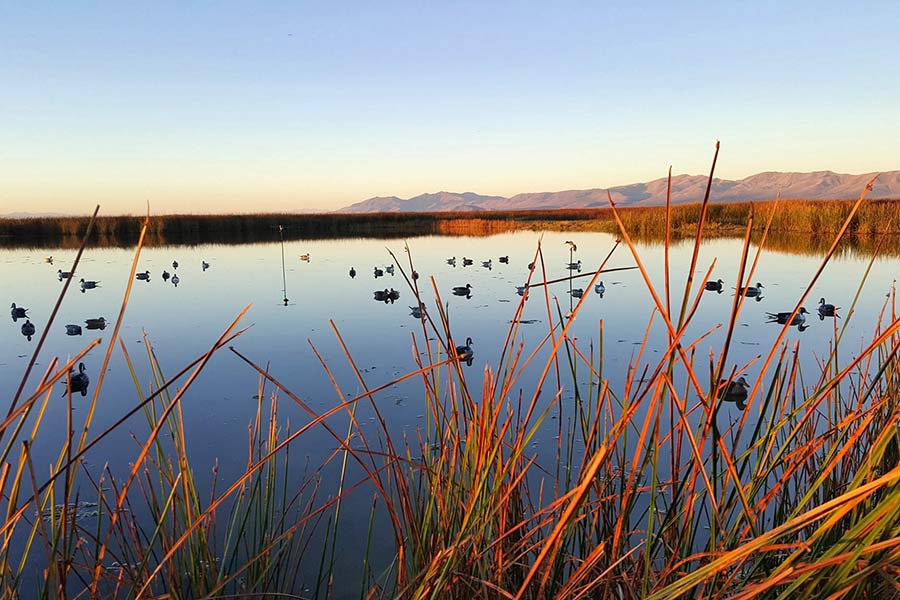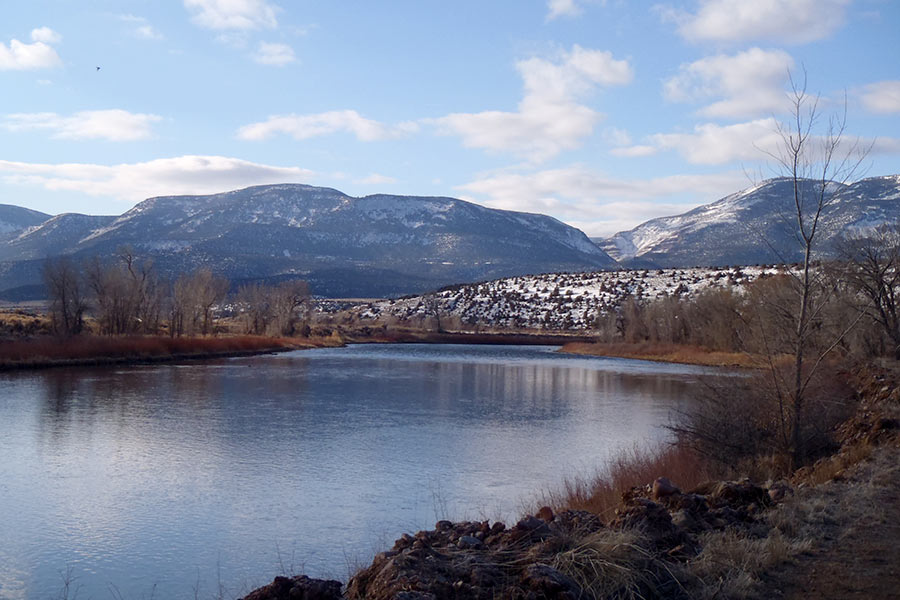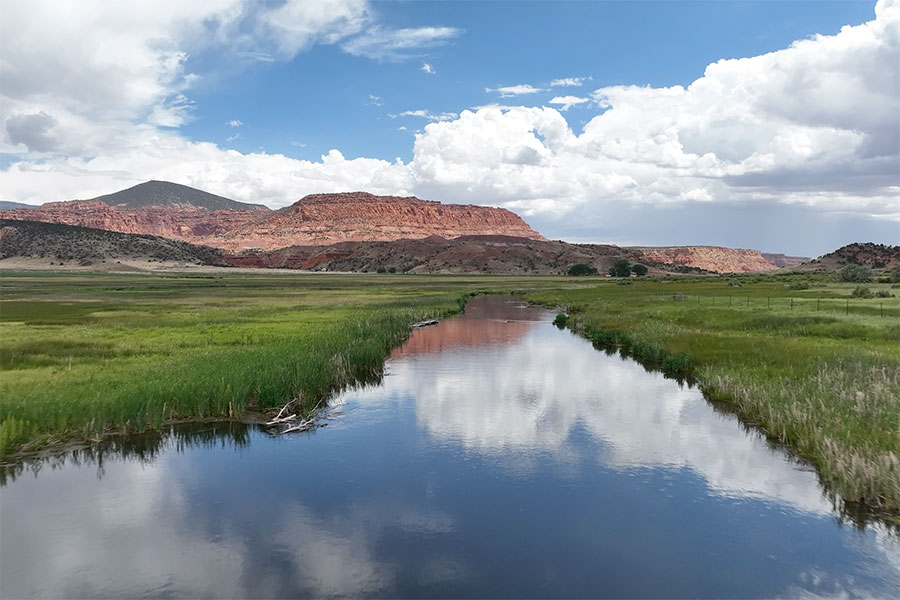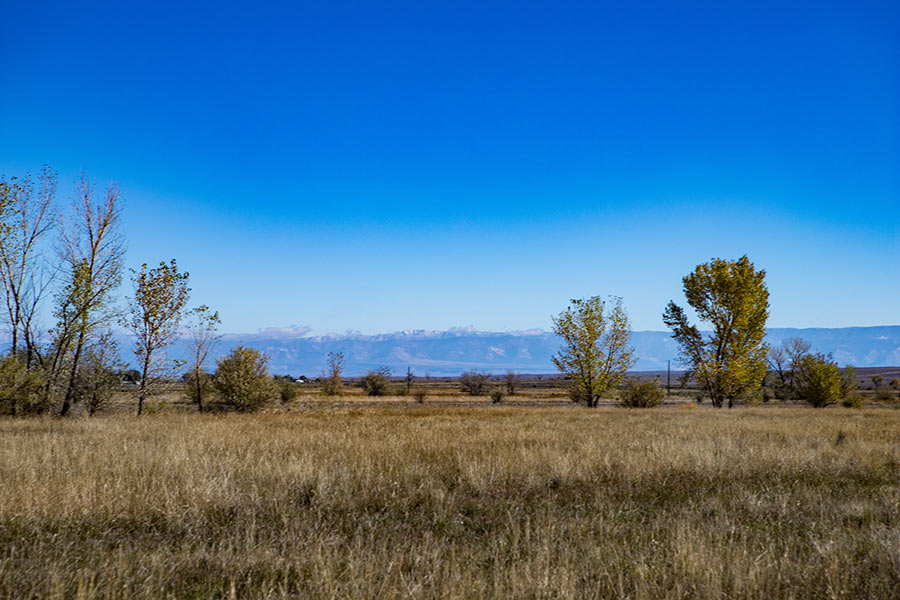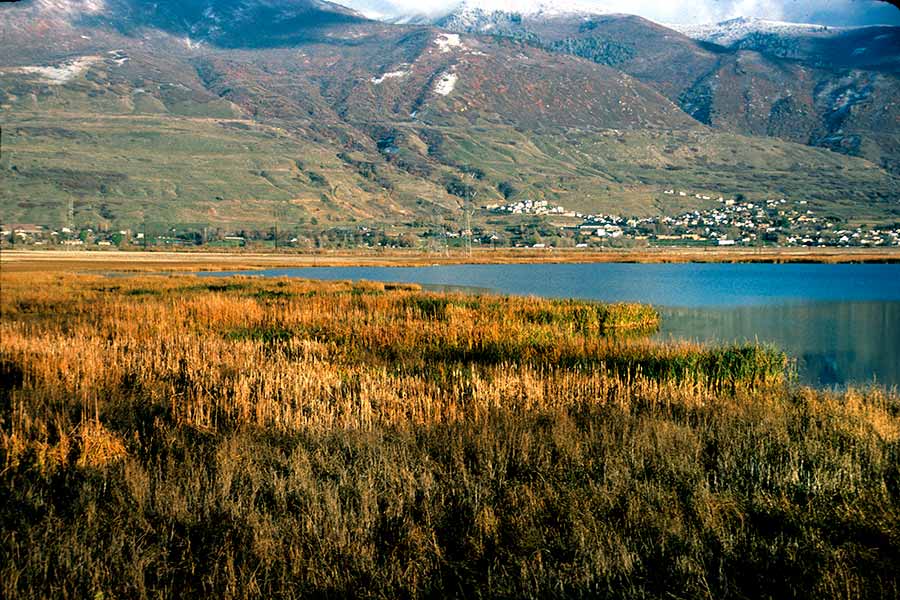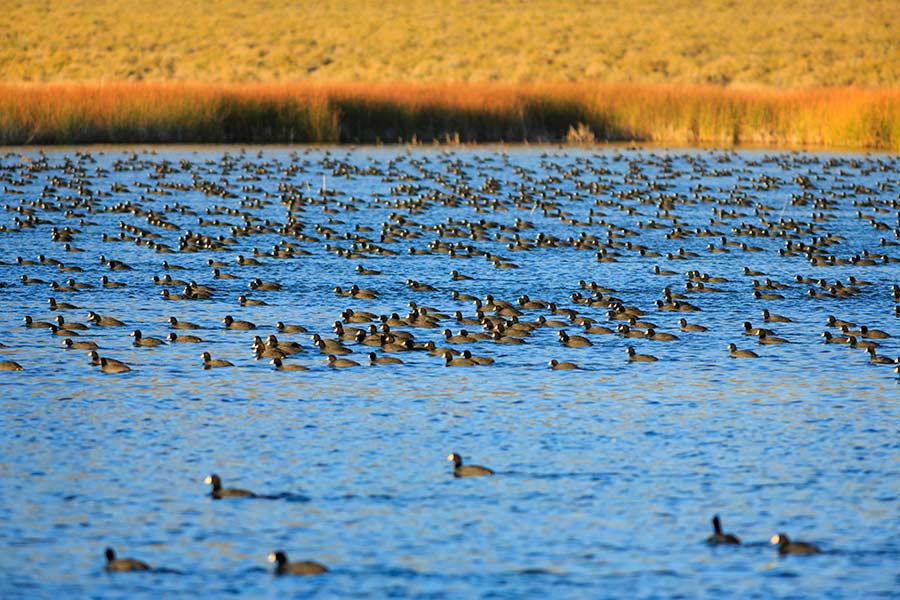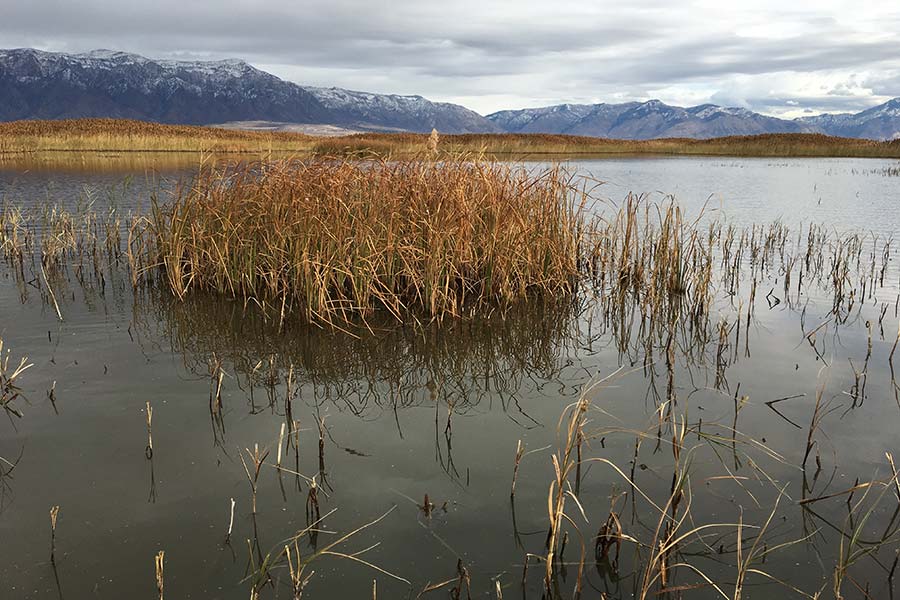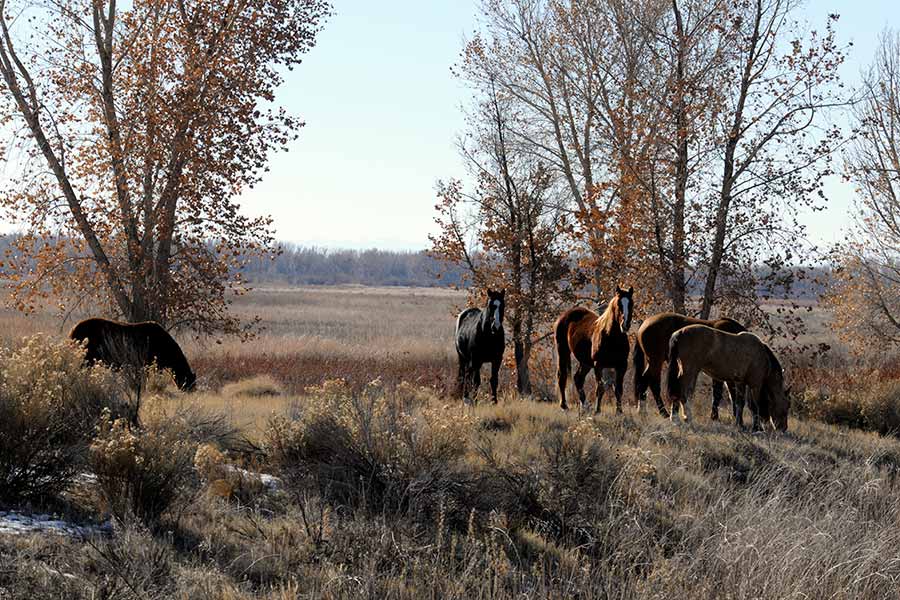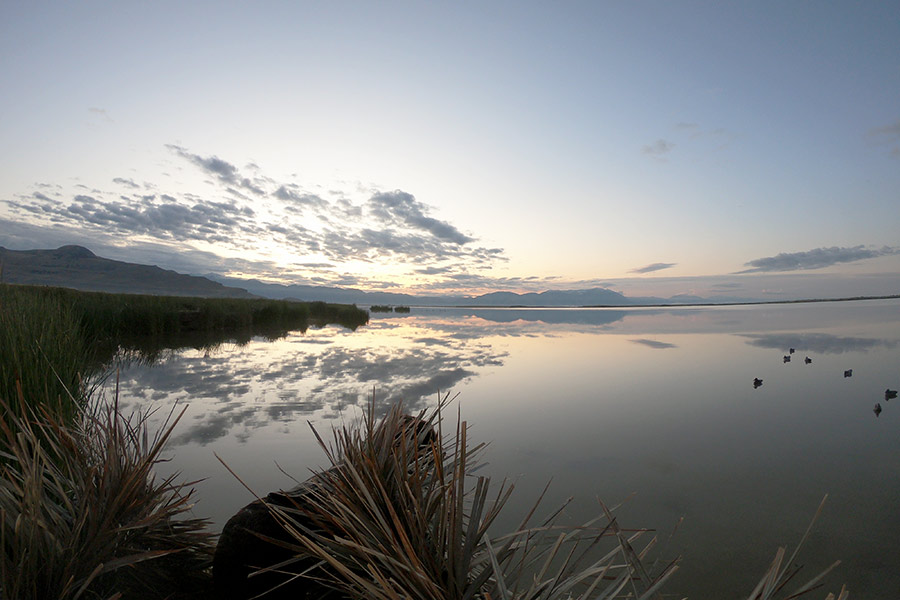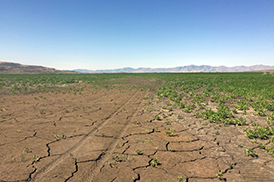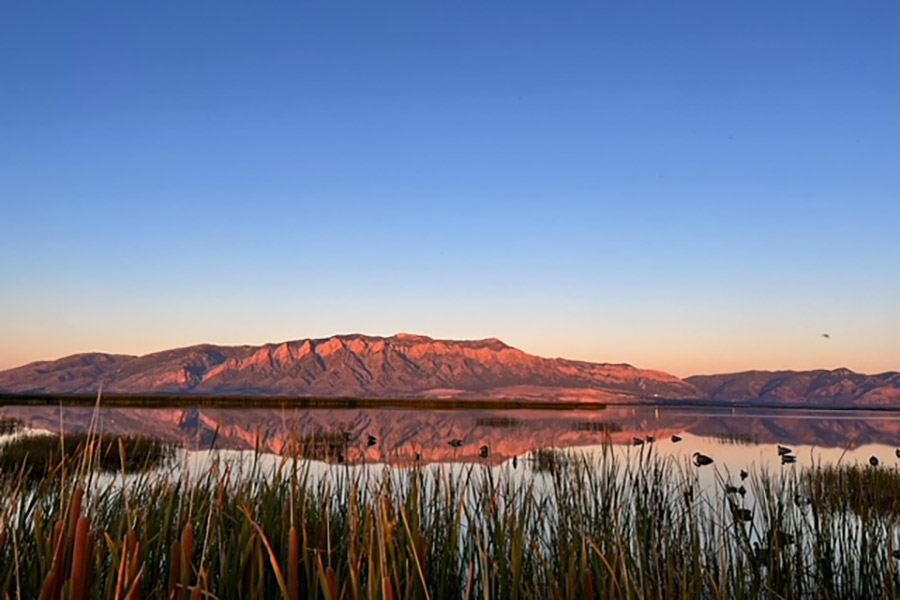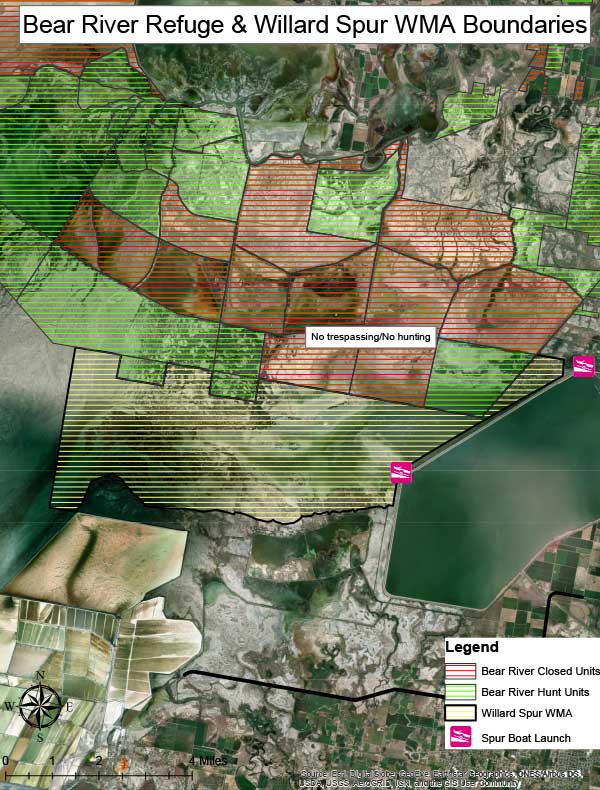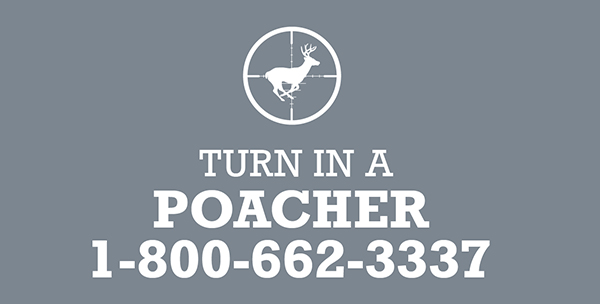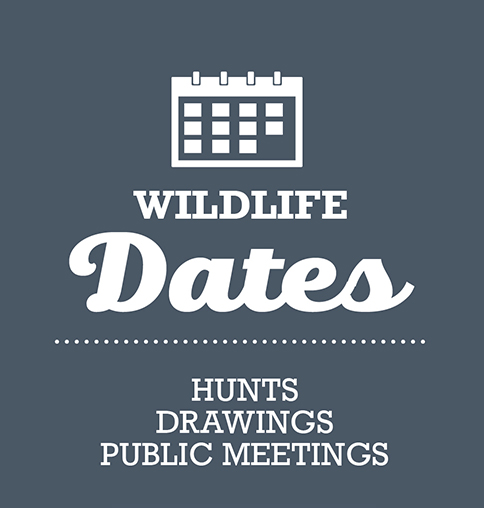Waterfowl hunt opener conditions
Conditions at specific waterfowl areas
The following areas are open to waterfowl hunting as of mid-September 2023. Tap or click each area to view its conditions:
Bear River Bay
Water/marsh conditions: Bear River Bay has held water all summer this year, and as of Sept. 11, there is enough water to launch a boat. Pondweed and other waterfowl food production was good to excellent.
Access: Gates will open Sept. 21. Roads and designated parking will be mowed before the Youth Hunt.
Bird use: Managers have been unable to visit this area for the past couple of months. However, given the water conditions, there should be plenty of waterfowl use this season.
General information: Bear River Bay is in the Northern goose area. Dark goose hunting will be closed Oct. 15–25.
Bear River Migratory Bird Refuge
The Bear River Migratory Bird Refuge is managed by the U.S. Fish & Wildlife Service.
Please see the following resources for more information about hunting and access at the Bear River Migratory Bird Refuge:
Browns Park WMA
Water/marsh conditions: Water levels at the Headquarters unit will be at hunt level. Water levels on the Butch Cassidy unit will be close to full. The Bridgeport unit will be low because a riser needs to be replaced so that water can be held at level. Ponds on the Parsons unit will be full. River levels are expected to range from 860 to 2500 cubic feet per second, depending on dam releases.
Access: Road access from Dutch John to the Bridgeport unit is in good condition. A section of the road to the Parsons unit is partially washed out and will require a high-clearance vehicle to cross. The swinging bridge is open in Colorado and has a maximum width of 8 feet.
Bird use: Current bird numbers are fair. Youth hunters should expect to see some birds, which typically decoy well. For the regular season opener, hunters will mostly see mallards, green-winged teal, wigeons and gadwalls. Hunters should expect to see fewer Canada geese this year.
General information: There may be a closure on the Headquarters or Parsons units to enable swan trapping and surveys to occur, which will depend on water levels and swan arrivals.
Clear Lake WMA, Topaz Slough WMA, Redmond Reservoir and Bicknell Bottoms WMA
Water/marsh conditions:
- Clear Lake: The spring flows at Clear Lake are similar to last year with no huntable water available for the opening of the season. The water levels will hopefully increase as the season progresses. The entire WMA has never been this dry. Areas south of the county road have no water. There is no water north of the county road for the beginning of the season. Like last year, the water will begin to fill areas as the weather cools down. The west marsh area continues to be dry. Conditions improve as the season progresses; more ducks show up and water increases with each passing week. With the wet winter and increased moisture in the area, there is optimism for some water to begin increasing. The underground water has not arrived yet.
- Topaz Slough: Marsh conditions at Topaz Slough are completely dry.
- Redmond: Redmond has good conditions on small impoundments, and also has foot access to the Sevier River.
- Bicknell Bottoms: Bicknell Bottoms has excellent conditions. Water levels are good, and waterfowl numbers are up this year. Much work has been done to improve the area for both waterfowl and upland hunting.
Access: All of the areas allow only non-motorized boats due to shallow water conditions. ATVs are prohibited in all areas listed.
Clarifications on the access at Redmond: The Utah Division of Wildlife Resources has a conservation easement area — managed similarly to our wildlife management areas — just south of Redmond Reservoir in Sevier County. However, the easement area does not include Redmond Reservoir. The reservoir is privately owned by the Redmond Lake Irrigation Company.
It has come to our attention that the private landowners feel as if the reservoir has had too much hunting pressure in recent years, and they are concerned about the amount of trash around the reservoir. Because of those concerns, they are considering closing the reservoir to hunting.
We recently met with the landowners to discuss the future of the reservoir with respect to hunting pressure and hunting/fishing access. Through these discussions, the landowner and the DWR have agreed to the following:
- Fishing access to the reservoir will remain unchanged.
- Hunting access for the Youth Waterfowl Hunt on Sept. 30 will be allowed.
- Hunting access beyond the Youth Waterfowl Hunt is currently uncertain, and the irrigation company may choose to limit or restrict access thereafter.
- Access to the north end of the DWR's easement area (along the dike from the parking area) will still be allowed.
- DWR law enforcement will be present during the youth hunt.
We understand this is a frustrating situation for those who've historically hunted at Redmond Reservoir, but we must also respect private property rights. We appreciate your patience as we continue to work through these potential access issues and strive for solutions that benefit all parties involved. If you have additional questions, please contact our Southern Region office at 435-865-6100.
Waterfowl use: Clear Lake duck numbers increase as the season progresses. Good numbers of ducks show up as soon as the weather turns colder. They are expected to continue increasing with peak numbers around Jan. 1. These ducks begin using flooded annual weeds and can provide some great late-season hunting with easy access. The most common ducks at Clear Lake are mallards, pintails and green-wing teal.
Good numbers of ducks and geese can be found at Bicknell Bottoms. Bicknell Bottoms offers good hunting both early season and late season. Redmond is generally better for duck hunting earlier in the season.
Upland bird hunting and fishing opportunities: Clear Lake, Redmond and Bicknell Bottoms are all good places to try pheasant hunting. Each area is open for pheasant hunting for 30 days and has excellent habitat for the birds and hunters to enjoy. Clear Lake, Redmond and Bicknell Bottoms all receive DWR-released pheasants each week during the general pheasant hunt. (See a map of these and other areas where pheasants are released in Utah.) Please check the current Utah Upland Game and Turkey Guidebook for details and shooting hours. If hunters are looking to get away from the crowds, try these areas.
Bicknell Bottoms also has excellent trout fishing.
General information:
- General waterfowl season is open Oct. 14, 2023 through Jan. 27, 2024. The Youth Waterfowl Hunt is Sept. 30.
- Youth pheasant and quail hunting is open statewide Oct. 28–Nov. 2.
- Steel shot is required to hunt at all times inside Clear Lake and Bicknell Bottoms.
- Gunnison Bend Reservoir is a large rest area in Delta. Many waterfowl stay there during the day and eventually fly off to go feed in the surrounding agricultural fields. Some success is found by scouting and asking permission to hunt private lands.
- Camping is allowed at Clear Lake in parking lots, and fires are permitted. Fires are the responsibility of the camper, and if you lose control of it, you pay for it. Please be aware of state fire restrictions and follow those rules accordingly.
Desert Lake WMA
Water/marsh conditions: Due to wet conditions in the area, most ponds are holding water well. One pond has a hole in the dike, and repair will occur this fall or possibly in the spring; it currently holds very little water. The ponds retained water during the whole year and should provide good cover and food for migrating birds this fall. Ponds are currently holding resident birds.
Access: The ponds can be accessed on the county roads that go through the property. Six parking lots can be found along the county roads for waterfowl hunters. No camping is allowed anywhere on the Desert Lake WMA. Please use adjacent BLM property for overnight use.
Bird use: Waterfowl numbers have begun to increase over the last month and should remain steady until the general opener. Waterfowl numbers typically go down following the opener until the migration begins. There should be waterfowl present for the Youth Hunt and they should decoy well. Common birds present include widgeons, gadwalls, mallards, green-wing teal, redheads and coots.
Farmington Bay WMA, Timpie Springs WMA & Layton-Kaysville WMA
Water/marsh conditions:
-
Farmington Bay WMA: Wetland conditions at Farmington Bay WMA are good inside the impounded units. Wetland conditions outside the impounded units could be unpredictable due to water levels. All units should be at hunt level by Oct. 7 in time for the waterfowl opener.
The habitat in the interior sheet-flow wetlands and impoundments within Farmington Bay WMA are in good condition due to aggressive herbicide treatments and/or cattle grazing on invasive phragmites. However, with this year's spring runoff, we did have an increase in phragmites growth within and outside of the units. Phragmites were treated with herbicide on all dike lines and other areas accessible by Marsh Masters, track machines and road vehicles during August of this year.
Cattle and drought stress management were also used to manage phragmites in many other areas throughout the WMA, in order to improve habitat conditions for waterfowl. Managers continued grazing treatments north of Turpin, which should provide excellent areas for birds to loaf and provide great hunting access, if and when managers have enough water available to flood the area. Improved habitat conditions should encourage excellent bird use at Farmington Bay WMA this year.
- Timpie Springs WMA: Although Timpie Springs WMA is a small wetland complex, marsh conditions and habitat are considered good to excellent. Specifically, the 1,440 total acres in Timpie Springs WMA consist of two large impoundments, some sheet-flow wetlands, mudflat and some areas of upland habitat. The wetland vegetation is characterized by low standing saltgrass, and a few bulrush species. Both ponds at Timpie Springs WMA are full and spilling water onto sheet-flow wetlands or surrounding mudflats.
- Layton-Kaysville WMA: Marsh conditions at Layton-Kaysville WMA are fair to poor due to phragmites encroachment and low water.
- Air-boating conditions at the WMAs: The shallow bays of the Great Salt Lake are in better condition this fall than last year due to all of the moisture we had in the spring. Hunters should consider hazards, multiple changes in vegetation and large expanses of mudflat that exist — and change yearly — outside the diked units in the open waters of Farmington Bay, Layton-Kaysville wetlands and the Great Salt Lake. Managers will allow water to spill from the airboat launch as long as the interior units and sheet-flow wetlands have the appropriate amount of water.
Access:
- All of the access points to Farmington Bay WMA will be open by 8 a.m. on Thursday, Sept. 21. Hunters using boats are encouraged to utilize the north entrance to launch into Unit 1 and Turpin. Access for small boats is located at the south entrance. Because of submerged hazards, a wakeless boat speed is recommended in all of the freshwater impoundments. Consider how well you'll be able to retrieve birds before you choose a place to hunt.
- Access to Timpie Springs WMA is permitted year-round.
- Access to Gaily wetlands will be open two days prior to the Youth Hunt, which occurs on Sept. 23.
- The DWR no longer manages the Layton-Kaysville access near Rouche Lane in west Farmington (the access is permanently closed). The DWR is working with UDOT on another access point in trade located in west Kaysville, which will provide better access for hunters. However, the parking area and access point will not be developed by the 2023–24 hunting season.
- There will be construction work in progress this October on the Turpin dike. The material (rock) for this project is currently stored around the edge of the Turpin parking lot. Please be aware of and cautious around the rock while in the parking lot during the season.
Bird use: There are currently large numbers of ducks and geese at Farmington Bay WMA. Managers anticipate an increase in bird use and distribution during September within our impounded wetlands, due to the good habitat conditions within them. (Especially when we start flooding all sheet-flow wetlands in mid-September.) Waterfowl hunters can expect to see large numbers of cinnamon teal, gadwalls and pintails early in the season. Diving ducks typically show up later in October. Tundra swans are typically harvested at Farmington Bay WMA in larger numbers during mid-to-late November, while dark goose hunting typically improves during the extended goose hunt.
General information:
- All of the areas listed above are open for hunting.
- The northwest corner of Unit 1 at Farmington Bay is a waterfowl rest area and is closed to hunting and trespass.
- The area west of the main entrance road, to the first right bend in the road, and north of the road until you get to Goose Egg Island, is closed except for educational purposes.
- Shooting is prohibited at Farmington Bay within 600 feet of all dikes, and any road open to motorized vehicles.
- Airboats are prohibited within diked units.
- The South Crystal unit is a motorless unit.
- Camping is allowed in parking areas only. Open fires are prohibited. Please clean your campsite so that we can continue to allow camping.
- The hunting blind for people with disabilities is available by reservation only. Contact David England at 385-405-4852 for reservations/rules.
Fish Springs National Wildlife Refuge
The Fish Springs National Wildlife Refuge is managed by the U.S. Fish & Wildlife Service.
Note: Southern Zone Youth Waterfowl Hunt
The Youth Waterfowl Hunt is Saturday, Sept. 30, 2023. The printed edition of the Utah Waterfowl Guidebook has an error on page 30. Please be assured the Southern Zone Youth Waterfowl Hunt is Saturday, Sept. 30, and waterfowl opener is Oct. 14.
Please see the following resources for more information:
Harold Crane WMA
Water/marsh conditions:
- Main impoundments: There is excellent aquatic vegetation growth in the south impoundment. The east and west impoundments were dry this summer so that surveys could be done. The center dike will be reconstructed next year, and we were preparing for that.
- Exterior flats: There are great conditions on flats to the east. Areas north and west of the impoundments are beginning to flood.
- Rainbow unit: As of mid-September, Rainbow Pond is filling with water and should have water throughout the hunt. The area north of the Rail Trail also looks good on the east end. It was burned and then grazed by cattle, and has good water.
Generally, marsh and impoundment conditions are great.
Access:
- Gates will open Thursday, Sept. 21.
- The road with three parking lots accessing the west Rainbow unit is in good condition. The main Harold Crane parking lot has been improved, also.
- The federal Bureau of Reclamation road to Harold Crane through Willard Bay Upland Game Area is in fair shape because of the hard work that our waterfowl maintenance crew has done. The headgate bridges are slightly narrower than the road, so be careful.
Bird numbers:
- Main impoundments: Great numbers of ducks on all impoundments.
- Rainbow unit: Fair number of birds north of the Rail Trail in the phragmites treatment area.
- Goose numbers are good overall.
General information: Hunting should be great for the Youth Hunt and general opener if the birds stick around.
Howard Slough WMA
Water/marsh conditions: Conditions are great in main impoundments. Water is at full pool/spilling levels and contains excellent sago pondweed growth. Some seasonal, small ponds on the Hooper Hot Springs unit are low and/or dry. The east side impoundment edge has also been chemically treated.
Access: The access road will be graded. Gates will be opened on Thursday, Sept. 21.
Bird numbers: Great bird numbers are in main impoundments. The grazed area has a lot of birds. Generally, duck numbers have been holding well, and goose and swan numbers have increased substantially the last few years here.
General information: Howard Slough WMA had some of the best WMA Youth Hunt success in the region the last few years and should be great again this year. It should hunt well throughout the season, also. For its size, it holds up very well under extremely heavy hunting pressure, and tundra swan hunting is expected to be good later on.
Locomotive Springs WMA
Water/marsh conditions: The water levels are very low and impoundments are dry. There is a little water along the East Lake dike.
Access: Roads are a little rough. Gates will open Sept. 21.
Bird use: Bird numbers are extremely low. Mallards, pintails and green-winged teal are the primary birds at this WMA. There are very few Canada geese.
General information:
- Locomotive Springs WMA is in the Northern goose area. Dark goose hunting will be closed Oct. 15–25.
- Camping is allowed in established parking areas, but there are no facilities available.
- Fires are the responsibility of the camper, and if you lose control of it, you pay for it. Please be aware of state fire restrictions and follow those rules accordingly.
Ogden Bay WMA
Water/marsh conditions:
- Unit 1: Pondweed growth is great on the main impoundment and excellent in the secondary impoundments. Screens were removed on all water-control structures that feed the area because of very high runoff. Because screens were removed to pass a lot of water, many carp have invaded the area. Over 1,000 acres of phragmites on the east side of the open water have been successfully grazed, but not as well as in past years. Cattle were put in a month-and-a-half later than planned because of high water.
- West of Unit 1: There was cattle grazing west of Unit 1, however the cattle were put in a month-and-a-half later than usual because of high water. Because of the late start, phragmites growth is much greater than in recent years
- Unit 2: Cattle were in the area this summer, but there is probably more cover left than normal. There has been water in this area for much of the summer. The area should be totally flooded by the end of September.
- Unit 3: Pondweed growth is excellent this year. Cattle have grazed the east side of the open water. Be advised that the rest area is in place on Unit 3. The rest area is very well posted and there is absolutely no trespassing allowed in this area. The rest area consists of the two small impoundments that are on the south side of the road as you head to the Unit 3 boat launch.
- Weber Delta: South Weber Delta was mostly wet this summer and is in fair condition. There is water in the river impoundment and most ponds at the north entrance.
- Pintail: Because of the high runoff this spring, the area was inundated with water throughout much of the summer. Cattle were put in the area a month-and-a-half later than normal. Because of the water and the late start with grazing, there are a lot of phragmites. However, there were over 2,000 acres that were sprayed by helicopter in August. This should make for great conditions next year.
Generally, all major impoundments are full and overflowing onto the westward flats. Marsh conditions are good to excellent in most areas. The Great Salt Lake elevation is currently 4193.6 feet, which is over three feet higher than this time last year.
Access: All outer gates to the lower parking lots and boat launches will be open on Thursday, Sept. 21. There is good vehicle access with most roadways and parking lots mowed and in good shape. Most access roads will be graded by the general opener.
The Unit 1 boat channel into main impoundments is clear and usable. The Unit 3 boat channel will be clear and usable.
Bird numbers: Duck production was some of the best that managers have seen in their careers. Thousands of ducks were produced at Ogden Bay, Howard Slough and Harold Crane WMAs.
- Unit 1: Good bird numbers are present in the main impoundments. Good numbers of birds are starting to build in the larger interior flats, which were reopened by grazing and are now flooded. Good numbers of ducks are starting to use secondary ponds, also.
- Unit 2: Bird numbers are increasing with additional water in the area. Farther west flats and far north-end ponds are expected, like last year, to gain a large number of birds when these areas totally refill and interior hunting forces birds out there.
- Unit 3: Good bird numbers in the main impoundment. The west flats are just starting to get water and bird numbers will increase as it floods. The east flats have good numbers of birds.
- Weber Delta: Fair numbers in general on North Weber Delta and fair numbers on South Weber Delta, but numbers will increase as these areas refill.
- Pintail: Good now, with an expectation of increasing to great numbers later on west side flats towards the Great Salt Lake.
Generally, birds are mostly concentrated on larger impoundments, ponds and flats in Units 1 and 3. Remote ponds and flats way west of impoundments will increasingly hold larger numbers of birds as they are displaced in easily accessible areas by hunters’ pre-hunt scouting activities and the Youth Hunt.
General information: The Youth Hunt should be great in the main impoundments and adjacent flats. The general opener should also be great. Hunting should be good as the season progresses and new birds arrive after all the pre-hunt scouting and weekend pressures subsides. Hunters in general will find the best hunting in the better habitat and bird concentration areas detailed above. Duck production was incredible nearly everywhere, and there are going to be a lot more young and inexperienced birds flying around this year.
Ouray National Wildlife Refuge
The Ouray National Wildlife Refuge is managed by the U.S. Fish & Wildlife Service.
Please see the following resources for more information:
Public Shooting Grounds WMA
Water/marsh conditions: Water conditions have been much better compared to years' past. All impoundments held water throughout the summer. Wetlands outside of impoundments — including south of Hull Lake, south of Wigeon Lake and the west marsh — had intermittent water through the summer months. All ponds on Public Shooting Grounds WMA will have water for the Youth Hunt, and boats will be able to launch and get to the majority of traditional hunting spots. Water outside of impounded areas will be decent for the Youth Hunt and should be completely flooded by the general opener. Pondweed and other waterfowl food production was good to excellent throughout Public Shooting Grounds.
Access: Gates will open the afternoon of Sept. 21. All roads and parking lots have been (or will be) mowed and graded before the general opener. Speed bumps have been installed on the main road near the blinds designated for physically challenged hunters. Please be careful and slow down.
Bird use: As of Sept. 11, bird numbers are fair, but they have just started to show up. They should continue to build in numbers as we approach the Youth Hunt and general opener. Mallards, pintails, green-winged teal, gadwalls, cinnamon teal and some redheads are present now. Wigeons are starting to show up in good numbers. There are also a fair number of Canada geese right now.
General information:
- Public Shooting Grounds WMA is in the Northern goose area. Dark goose hunting will be closed Oct. 15–25.
- Camping is allowed in established parking areas, but there are no facilities available.
- Fires are allowed in fire pits only, and are the responsibility of the camper; if you lose control of it, you pay for it. Please be aware of state fire restrictions and follow these rules accordingly.
- Please respect posted signs and regulations, along with regulations in the Utah Waterfowl Guidebook.
- Blinds for physically challenged hunters are available on a first-come, first-served basis. You must possess a DMV-issued physically challenged sticker or license plate to use these blinds.
- Wigeon Lake is a non-motorized-boats-only waterbody.
- The tundra swan hunting boundary has been extended north to Highway 83. South Public Shooting Grounds will be open to tundra swan hunting.
- North Public Shooting Grounds (north of Highway 83) is still closed to tundra swan hunting.
- Remember: The harvest of trumpeter swans is now illegal; see the Utah Waterfowl Guidebook for more information about swan regulations.
Salt Creek WMA
Water/marsh conditions: All of Salt Creek WMA held water throughout the summer except for Stilt pond in the northwest corner of the WMA. The units on the east side of Salt Creek, Gadwall, Canvasback, Redhead, Mallard Teal and Goose were full all summer and produced good to excellent pondweed. Both Ibis and Stilt ponds held water all summer and produced fair pondweed. The main bay of Salt Creek produced good to excellent pondweed. Managers anticipate having full water levels for both the Youth Hunt and general opener.
Bird use: Birds have just started to show up and will continue to build heading into the Youth Hunt. You should see mallards, pintails, green-winged teal, gadwalls, cinnamon teal and wigeons at Salt Creek. There are a fair number of Canada geese around right now.
Access: Gates will open the afternoon of Sept. 21. All roads and parking lots have been (or will be) mowed and graded before the general opener. Please be careful and slow down on WMA roads.
General information:
- Salt Creek WMA is in the Northern goose area. Dark goose hunting will be closed Oct. 15–25.
- Camping is allowed in established parking areas, but there are no facilities available.
- Fires are allowed in fire pits only and are the responsibility of the camper; if you lose control of it, you pay for it. Please be aware of state fire restrictions and follow these rules accordingly.
- Please respect posted signs and regulations, along with regulations in the Utah Waterfowl Guidebook.
- Salt Creek WMA is closed to tundra swan hunting.
- Blinds for physically challenged hunters are available on a first-come, first-served basis. You must possess a DMV-issued physically challenged sticker or license plate to use these blinds.
Willard Spur WMA
If you plan on hunting the Willard Spur Waterfowl Management Area this fall hunting season, please be aware of the following two things:
- Access to the parking lot has changed slightly. The road that used to take you to the parking lot now has a Utah State Parks toll booth on it. Do not turn there. Instead, stay on the paved road and travel about a quarter of a mile north. You'll come to an access road that bends to the west. That new road will take you to the parking area!
- The WMA shares a boundary with the Bear River Migratory Bird Refuge. On the map below, you can see that much of the refuge that borders the WMA is open to hunting. However, two sizable portions — marked in red — are not.
The U.S. Fish & Wildlife Service has marked the boundary with signs. If you hunt along the boundary this season, please watch for these signs to make sure you're in an area that's open to hunting. To see season dates and other rules and regulations, please see the current Utah Waterfowl Guidebook.
Maps
Tap or click the following areas for maps:
Waterfowl Management Areas
- Swan hunting boundary
- Bicknell Bottoms WMA
- Browns Park WMA
- Clear Lake WMA
- Desert Lake WMA
- Farmington Bay WMA
- Harold Crane WMA
- Howard Slough WMA
- Locomotive Springs WMA
- Ogden Bay WMA
- Public Shooting Grounds WMA
- Salt Creek WMA
- Timpie Springs WMA
- Topaz WMA
- Willard Spur WMA
National wildlife refuges
- Bear River Migratory Bird Refuge
- Fish Springs National Wildlife Refuge
- Ouray National Wildlife Refuge
If you have questions about waterfowl hunt opener conditions or Waterfowl Management Areas in northern Utah, contact the DWR Northern Region office at 801-476-2740 or Salt Lake office at 801-538-4700.


